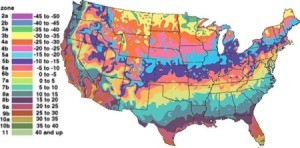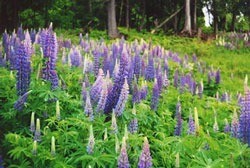 As every gardener knows, different plants are adapted to growing well in specific climates. An orange tree will not tolerate a Minnesota winter (outdoors anyway) any more than Arizona's Saguaro cactus will tolerate the warm humid conditions of Florida. Plant hardiness zones help to define the optimum growing climates for particular groups of plants. By knowing what hardiness zone you live in, you can properly select the plants that are best suited to your growing conditions.
As every gardener knows, different plants are adapted to growing well in specific climates. An orange tree will not tolerate a Minnesota winter (outdoors anyway) any more than Arizona's Saguaro cactus will tolerate the warm humid conditions of Florida. Plant hardiness zones help to define the optimum growing climates for particular groups of plants. By knowing what hardiness zone you live in, you can properly select the plants that are best suited to your growing conditions.
In the Mid-1900s, the United States Department of Agriculture (USDA) drew up a map that included 11 different plant hardiness zones for the United States, Mexico and Canada. Zones were defined by average annual minimum temperature. A 10 degree F difference separated each zone. The map was originally created for the agricultural industry as a tool to help farmers select hardy plant varieties, but it also works for our native landscapes and gardens today.
Over the years, there have been several updates to the map. In 1990, each numbered zone was further sub-divided with the letters "a" and "b", representing the low and high end of the temperatures within each 10 degree F zone ("a" the low end, "b" the high end). In general, higher zone numbers are warmer.
Most major nurseries and seed companies use the USDA Plant Hardiness Zone Map when labeling their horticultural products for consumers, but make sure the products you purchase or order through the mail are actually suited to your zone. This is especially true when buying plants from chain brand discount stores with garden centers. They sometimes offer the same plants for sale in all their stores nationwide.
The USDA Plant Hardiness Zone Map can tell you the "average" minimum temperatures in your zone. This date has been acquired from years of weather records and is particularly useful for planting trees, shrubs and perennial plants. When a plant has been labeled for zone 5, for example, it means it has adapted well to withstand the minimum average temperature (-20°F) in zone 5. This does not necessarily mean that if you live in warmer zone 9, that you are automatically safe to grow to grow this same plant. There is no doubt that the same plant will survive zone 9's lowest average annual temperature, but mere survival does not guarantee good performance. Instead, the warm temperatures and humidity of zone 9 that prove fatal.
The USDA Plant Hardiness Zone Map is a useful guide, but it is only one small part of the picture. There are several other factors to consider:
Growing Season (Frost Dates): One of the most important factors for determining which plants are most suited to your area is your growing season. A growing season is defined by the total number of frost-free growing days. This is especially important to know when growing vegetables and annuals. If you live in zone 2 for example, seeds that need longer than 90 days to grow (total number of frost free days) will need to be started indoors. Frost dates can also vary significantly depending on the topography of your area. If you live high on a hill, or deep in a valley, your frost dates may be different than your fellow gardeners across town.
Environmental Factors: Wind, soil type, moisture, sunshine, heat, humidity, fertility, drainage and day length all have an effect on growth performance.

It's not nice to fool Mother Nature, but for gardeners in cooler zones, it isn't uncommon to experience a little "zone envy" once in awhile. Plants may or may not survive in zones warmer or cooler than they are rated for, but there are ways to "stretch" your zone by sneaking in a few extra growing days.
Hot caps, row covers and blankets can be used to ward off early or late frosts and squeeze in a few more days on either end of the season.
Cold frames or starting seeds indoors will accelerate germination by several weeks and provide protection against cold temperatures.
Greenhouses are perhaps the best way to create a frost free zone year round.
Many factors influencing plant winter hardiness have changed since the last USDA Plant Hardiness Zone Map was updated in 1990. Having received a grant from the USDA, the United States National Arboretum is currently in the process of creating a new and improved (and more accurate) version of the Plant Hardiness Zone Map. This new map will expand the zones to 15 and will document the tolerances of plants taking into consideration several 21st century factors.
Editor's Note: Here a link to the updated interactive USDA Plant Hardiness Zone Map which locates your zone via your zip code.
This page contains the following solutions.
Because of climate change, our growing zone has officially changed. I am in the Washington DC area. So, check your zone and plan your planting timetable accordingly.
Here are the questions asked by community members. Read on to see the answers provided by the ThriftyFun community.
I believe I am in a zone 4 or 5, but I am not sure. I live in Massachusetts.
How do I know what zone I'm in?
By Holly from Lancaster, WI
Here's a good map. www.usna.usda.gov/
The one below, just enter your zip code.
www.backyardgardener.com/
A call or visit to your local garden center should be able to answer that question. Home Depot or lowes is not your local garden center.
Or call your USDA county extension agent (should be in the government pages in the phone book).
Hardiness Zone: 6a
Thanks you!
Katie from PA
A: Katie,
It's not surprising that you've experienced some confusion over which hardiness zone you're in. Currently, there are at least three different hardiness zone maps floating around on the Internet, in books, magazines and seed catalogs. The USDA created the first U.S. hardiness zone map in the mid 1900's. Since then, Agriculture Canada and Harvard University have also come out with maps.
The American Horticultural Society is currently working on yet another version of the 1990 hardiness zone map for the USDA. As of now, there is no word on when the new map will be ready. Thirty years worth of climate data, including the length of cold spells and airflow patterns are being studied to determine the new hardiness zones. The new version of the map will no longer feature 'a' and 'b' distinctions in each zone and will include 15 zones instead of 11 to reflect growing regions for sub-tropical and tropical plants. Until then, if you're interested in complicating your gardening life even further, check out the American Horticultural Society's website and read about your "Heat Zone." http://www.ahs.org/publications/heat_zone_map.htm
Ellen
It depends where in PA you are. There are 5 differant hardiness zones there. Check out this map:
www.growit.com/
Oh thank you so much! I really appreciate the help...LOL...I thought I was losing it. Thank you!!